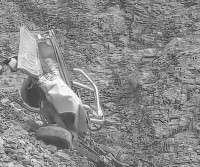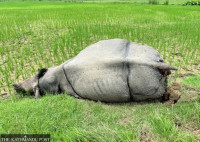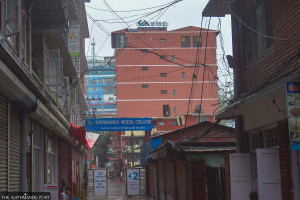Bagmati Province
High-voltage electric fences turn Chitwan farmlands into death traps
In buffer zones of the Chitwan National Park, desperate farmers battling relentless raids on their crops by wildlife are increasingly installing high-voltage electrical fences that are now killing not only animals, but humans as well.
Ramesh Kumar Paudel
Efforts by farmers to protect their crops from wild animals in the buffer zones of Chitwan National Park have turned deadly. Electric fences—illegally rigged with live current to ward off animals—have claimed lives of not only endangered species but also humans.
On Wednesday morning, two deaths were reported in separate locations in the vicinity of the protected area—a man and a one-horned rhinoceros. Both were victims of electrocution by unauthorised electric fences placed around paddy fields.
Lal Bahadur Moktan, aged 33, of ward 1 of Rapti Municipality in Chitwan, was found dead in his paddy field in Jogital, located in ward 6 of Manahari Rural Municipality in Makawanpur district. According to officials from Chitwan National Park, Moktan had accidentally come into contact with an electrified wire fence he had installed himself to keep wild animals—particularly elephants and rhinos—away from his crops.
Just as news of Moktan’s death emerged, park officials were informed that a one-horned rhino was also electrocuted earlier that morning at Bhairabpur in ward 2 of Madi Municipality in Chitwan. Hari Bhakta Shrestha set up a similar electric trap in his field to protect his rice crop. Preliminary investigations suggest the rhino was fatally shocked while attempting to enter the field.
While buffer zone communities are legally permitted to build certain types of fences—such as mesh wire or low-voltage electric lines that deliver only a mild shock—lethal electric traps like those that killed Moktan and the rhino are illegal. These high-voltage setups bypass safety mechanisms and pose a fatal risk to both wildlife and humans.
“This is not the first time wildlife has died from electric traps. But now even humans are losing their lives to these illegal defenses,” said Abinash Thapa Magar, information officer at Chitwan National Park. According to park officials, a one-horned rhino had also died from electrocution last fiscal year, and at least eight rhinos have been killed this way since the fiscal year of 2016-17. The increasing frequency of such incidents raises serious concerns about the safety and legality of the methods being used by farmers to protect their crops.
The buffer zone of Chitwan National Park spans 728 square kilometers and includes parts of Chitwan, Nawalparasi East, Makawanpur and Parsa districts, encompassing one metropolitan city, eight municipalities and three rural municipalities. It is home to more than 300,000 people across 45,000 households. Human-wildlife conflict in these areas is intense, with elephants, rhinos and wild boars causing widespread damage to crops.
In the last fiscal year alone, 456 crop damage incidents were reported in the buffer zone. Of these, 255 were caused by rhinos, 67 by elephants, and 100 by wild boars, according to park records.
“In areas like Madi and Manahari, which lack permanent barriers like concrete walls, farmers are resorting to these high-risk electric traps. And even in areas where legal electric fences were once installed, many have fallen into disrepair,” said Man Bahadur Syangbo, chairman of the Lothar Buffer Zone Users Committee.
Earlier, the committee had installed controlled low-voltage electric fences in the Jogital area, but these became ineffective over time. Subsequent attempts by local ward offices to repair or replace them also failed, leaving the area virtually without any fencing.
“Due to insufficient barriers and lack of maintenance, fields have become increasingly vulnerable. Farmers feel they have no choice but to take extreme measures,” Syangbo added.
Although buffer zone management authorities recognise the growing risk, they cite budget constraints as a major hurdle in building durable infrastructure. “Installing concrete walls costs millions and our annual budget has been shrinking. From about Rs4 million to Rs 4.2 million annually in the past, we now receive even less,” lamented Syangbo.
Park officials admit that compensation for crop losses due to wildlife damage is also inadequate. “Farmers get a maximum of Rs10,000 per crop season in compensation. But actual losses, especially during harvest season, can be many times higher,” said Prakash Dhungana, chairman of the Buffer Zone Management Committee.
This gap between losses and compensation is forcing many farmers towards illegal and dangerous practices. Despite legal consequences—including fines of up to Rs1 million and imprisonment of up to 15 years for killing an endangered rhino or trafficking its body parts—desperate farmers continue to risk prosecution and even their lives, by installing electric traps.
In October 2023, a young man in Ayodhyapuri of Madi, was killed after getting tangled in a supposedly ‘non-lethal’ electric fence. Such deaths show that even legal low-voltage systems are not without danger if poorly maintained or improperly used.
“These traps may seem like quick fixes, but they’re turning fields into death zones—for rhinos, elephants, and now people,” said Thapa Magar. “We’ve observed a rise in unauthorised high-voltage traps over the last two to three years. It's a dangerous trend,” he added.
As pressure mounts to protect livelihoods, the challenge for authorities is twofold: to prevent further deaths of humans and wildlife, and to provide sustainable, safe, and lawful alternatives for crop protection in Nepal’s most wildlife-rich regions.




 28.26°C Kathmandu
28.26°C Kathmandu

1.jpg)














